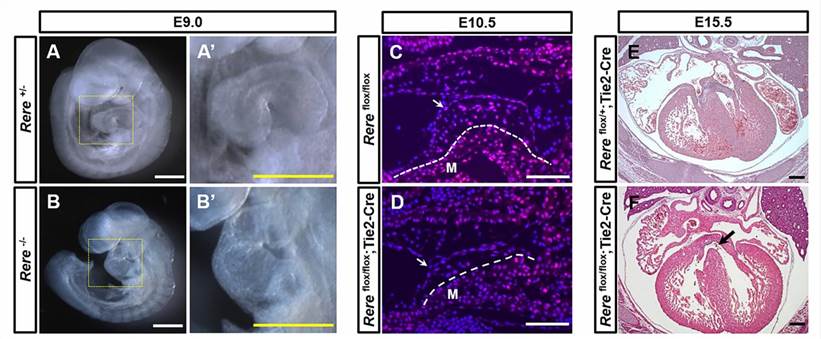RERE and Associated Diseases
After years of exploration and accumulation, Creative Biolabs has developed into a leader in the field of gene therapy. We would like to share cutting-edge research and information in this field with you. Here, we briefly describe the arginine-glutamic acid dipeptide repeats gene (RERE) and related diseases.
Overview of RERE
The protein encoded by the RERE colocalizes with transcription factors in the nucleus. By forming complexes with nuclear receptors and other transcription factors, RERE is involved in regulating the expression of specific genes. The function of RERE was first demonstrated in animal models, in which RERE was shown to be closely associated with the development and function of multiple organs, including the inner ear, eye, brain, heart, and kidney. Furthermore, RERE acts as a key regulator of retinoic acid signaling during embryonic development.
 Fig.1 Ablation of RERE in the endocardium leads to the development of ventricular septal defects. (Kim, 2018)
Fig.1 Ablation of RERE in the endocardium leads to the development of ventricular septal defects. (Kim, 2018)
RERE and Associated Diseases
Many phenotypes are present in individuals with pathogenic variants in RERE. Some people suffer from isolated several disorders such as autism, developmental delay as well as intellectual disability while others are accompanied by various structural birth defects such as hearing loss, vision problems, structural brain abnormalities, and congenital heart defects. Diseases involving RERE mainly include neurodevelopmental disorders with or without anomalies of the brain, eye, or heart (NEDBEH) and chromosome 1P36 deletion syndrome.
- NEDBEH
NEDBEH is an autosomal dominant disease that affects many body systems, especially the nervous system. It is characterized by stunting, intellectual disability, and behavioral disturbances in infancy. Additionally, some individuals may be accompanied by muscle weakness and seizures.
- 1P36 deletion syndrome
It is a chromosomal disease that often accompanies severe intellectual disability. Individuals with this disorder may be accompanied by abnormal brain structures and vision or hearing problems. In addition, some individuals have abnormalities of the bones, heart, gastrointestinal system, kidneys, or genitals. There is no cure for this syndrome. Treatment depends on symptoms and mainly includes a rehabilitation program, anti-seizure medications, and standard treatment for heart, eye, and hearing problems.
RERE Related Mechanisms
Overexpression of the protein encoded by the RERE gene can trigger apoptosis. A similar protein in mice associates with histone deacetylases and functions as a transcriptional co-repressor of embryonic growth. Moreover, evidence suggests that RERE deficiency leads to optic atrophy through retinal cell degeneration. Since RERE acts as a transcription factor to regulate target gene expression, it is likely to regulate one or more signaling pathways during some organ development.
If you would like to learn more about gene therapy or our related custom services, please feel free to contact us to discuss your plans or send an email to inform you of specific needs.
Reference
- Kim, B. J.; et al. RERE deficiency leads to decreased expression of GATA4 and the development of ventricular septal defects. Disease Models & Mechanisms. 2018, 11(9): dmm031534. Distributed under Open Access license CC BY 3.0, without modification.
